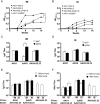Protection against henipavirus infection by use of recombinant adeno-associated virus-vector vaccines
- PMID: 23175762
- PMCID: PMC7107322
- DOI: 10.1093/infdis/jis699
Protection against henipavirus infection by use of recombinant adeno-associated virus-vector vaccines
Abstract
Nipah virus (NiV) and Hendra virus (HeV) are closely related, recently emerged paramyxoviruses that are capable of causing considerable morbidity and mortality in several mammalian species, including humans. Henipavirus-specific vaccines are still commercially unavailable, and development of novel antiviral strategies to prevent lethal infections due to henipaviruses is highly desirable. Here we describe the development of adeno-associated virus (AAV) vaccines expressing the NiV G protein. Characterization of these vaccines in mice demonstrated that a single intramuscular AAV injection was sufficient to induce a potent and long-lasting antibody response. Translational studies in hamsters further demonstrated that all vaccinated animals were protected against lethal challenge with NiV. In addition, this vaccine induced a cross-protective immune response that was able to protect 50% of the animals against a challenge by HeV. This study presents a new efficient vaccination strategy against henipaviruses and opens novel perspectives on the use of AAV vectors as vaccines against emergent diseases.
Figures




References
-
- Chua KB, Goh KJ, Wong KT, et al. Fatal encephalitis due to Nipah virus among pig-farmers in Malaysia. Lancet. 1999;354:1257–9. - PubMed
-
- Hess IM, Massey PD, Walker B, Middleton DJ, Wright TM. Hendra virus: what do we know? N S W Public Health Bull. 2011;22:118–22. - PubMed
-
- Murray K, Selleck P, Hooper P, et al. A morbillivirus that caused fatal disease in horses and humans. Science. 1995;268:94–7. - PubMed
Publication types
MeSH terms
Substances
LinkOut - more resources
Full Text Sources
Other Literature Sources

